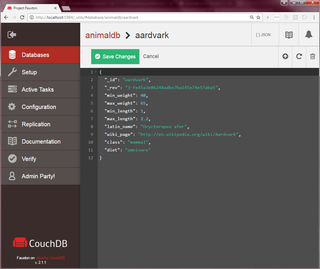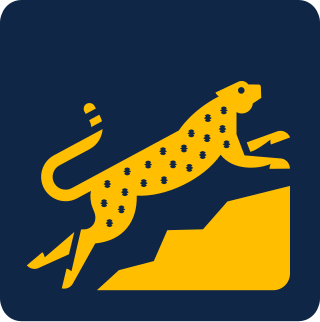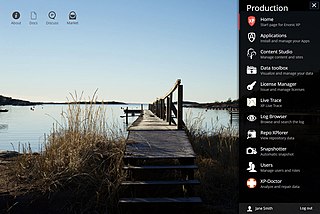
MySQL is an open-source relational database management system (RDBMS). Its name is a combination of "My", the name of co-founder Michael Widenius's daughter My, and "SQL", the acronym for Structured Query Language. A relational database organizes data into one or more data tables in which data may be related to each other; these relations help structure the data. SQL is a language that programmers use to create, modify and extract data from the relational database, as well as control user access to the database. In addition to relational databases and SQL, an RDBMS like MySQL works with an operating system to implement a relational database in a computer's storage system, manages users, allows for network access and facilitates testing database integrity and creation of backups.

PostgreSQL, also known as Postgres, is a free and open-source relational database management system (RDBMS) emphasizing extensibility and SQL compliance. PostgreSQL features transactions with atomicity, consistency, isolation, durability (ACID) properties, automatically updatable views, materialized views, triggers, foreign keys, and stored procedures. It is supported on all major operating systems, including Linux, FreeBSD, OpenBSD, macOS, and Windows, and handles a range of workloads from single machines to data warehouses or web services with many concurrent users.
The following tables compare general and technical information for a number of relational database management systems. Please see the individual products' articles for further information. Unless otherwise specified in footnotes, comparisons are based on the stable versions without any add-ons, extensions or external programs.

Apache CouchDB is an open-source document-oriented NoSQL database, implemented in Erlang.
An embedded database system is a database management system (DBMS) which is tightly integrated with an application software; it is embedded in the application. It is a broad technology category that includes:
Spacewalk is open-source systems management software for system provisioning, patching and configuration licensed under the GNU GPLv2.
MongoDB is a source-available, cross-platform, document-oriented database program. Classified as a NoSQL database product, MongoDB utilizes JSON-like documents with optional schemas. MongoDB is developed by MongoDB Inc. and current versions are licensed under the Server Side Public License (SSPL). MongoDB is a member of the MACH Alliance.
Moose File System (MooseFS) is an open-source, POSIX-compliant distributed file system developed by Core Technology. MooseFS aims to be fault-tolerant, highly available, highly performing, scalable general-purpose network distributed file system for data centers. Initially proprietary software, it was released to the public as open source on May 30, 2008.
Redis is a source-available, in-memory storage, used as a distributed, in-memory key–value database, cache and message broker, with optional durability. Because it holds all data in memory and because of its design, Redis offers low-latency reads and writes, making it particularly suitable for use cases that require a cache. Redis is the most popular NoSQL database, and one of the most popular databases overall. Redis is used in companies like Twitter, Airbnb, Tinder, Yahoo, Adobe, Hulu, Amazon and OpenAI.
LevelDB is an open-source on-disk key-value store written by Google fellows Jeffrey Dean and Sanjay Ghemawat. Inspired by Bigtable, LevelDB source code is hosted on GitHub under the New BSD License and has been ported to a variety of Unix-based systems, macOS, Windows, and Android.

Basho Technologies was a distributed systems' company that developed a key-value NoSQL database technology, Riak, and an object storage system built upon the Riak platform, called Riak CS.
FoundationDB is a free and open-source multi-model distributed NoSQL database developed by Apple Inc. with a shared-nothing architecture. The product was designed around a "core" database, with additional features supplied in "layers." The core database exposes an ordered key–value store with transactions. The transactions are able to read or write multiple keys stored on any machine in the cluster while fully supporting ACID properties. Transactions are used to implement a variety of data models via layers.
Druid is a column-oriented, open-source, distributed data store written in Java. Druid is designed to quickly ingest massive quantities of event data, and provide low-latency queries on top of the data. The name Druid comes from the shapeshifting Druid class in many role-playing games, to reflect that the architecture of the system can shift to solve different types of data problems.
In distributed computing, a conflict-free replicated data type (CRDT) is a data structure that is replicated across multiple computers in a network, with the following features:
- The application can update any replica independently, concurrently and without coordinating with other replicas.
- An algorithm automatically resolves any inconsistencies that might occur.
- Although replicas may have different state at any particular point in time, they are guaranteed to eventually converge.

RocksDB is a high performance embedded database for key-value data. It is a fork of Google's LevelDB optimized to exploit multi-core processors (CPUs), and make efficient use of fast storage, such as solid-state drives (SSD), for input/output (I/O) bound workloads. It is based on a log-structured merge-tree data structure. It is written in C++ and provides official language bindings for C++, C, and Java. Many third-party language bindings exist. RocksDB is free and open-source software, released originally under a BSD 3-clause license. However, in July 2017 the project was migrated to a dual license of both Apache 2.0 and GPLv2 license. This change helped its adoption in Apache Software Foundation's projects after blacklist of the previous BSD+Patents license clause.

Enonic XP is a free and open-source web application platform and content management system (CMS) in one based on Java and Elasticsearch. Developed by the Norwegian software company Enonic, the microservice web platform can be used to build progressive web applications, Next.js websites, or web-based APIs. Enonic XP uses an application framework for coding server logic with JavaScript, and has no need for SQL as it ships with an integrated content repository. The CMS is fully decoupled, meaning developers can create traditional websites and landing pages, or use XP in headless mode, that is without the presentation layer, for loading editorial content onto any device or client. Enonic is used by major organizations in Norway, including the national postal service Norway Post, the insurance company Gjensidige, the national lottery Norsk Tipping, the Norwegian Labour and Welfare Administration, and all the top football clubs in the national football league for men, Eliteserien.
TiDB is an open-source NewSQL database that supports Hybrid Transactional and Analytical Processing (HTAP) workloads. Designed to be MySQL compatible, it is developed and supported primarily by PingCAP and licensed under Apache 2.0. It is also available as a paid product. TiDB drew its initial design inspiration from Google's Spanner and F1 papers.
RavenDB is an open-source document-oriented database written in C#, developed by Hibernating Rhinos Ltd. It is cross-platform, supported on Windows, Linux, and Mac OS. RavenDB stores data as JSON documents and can be deployed in distributed clusters with master-master replication.

Valkey is an open-source in-memory storage, used as a distributed, in-memory key–value database, cache and message broker, with optional durability. Because it holds all data in memory and because of its design, Valkey offers low-latency reads and writes, making it particularly suitable for use cases that require a cache. Valkey is the successor to Redis, the most popular NoSQL database, and one of the most popular databases overall. Valkey or its predecessor Redis are used in companies like Twitter, Airbnb, Tinder, Yahoo, Adobe, Hulu, Amazon and OpenAI.






